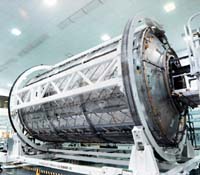
|
Flight 9 - 5A
- Launch Date:
- 7. Feb. 2001
- Launch Vehicle:
- US Space Shuttle: STS-98
- Elements:
- US Laboratory Module
|
- Provides initial US user capability.
- Launched with 5 system racks already installed inside of the module.
- Control Moment Gyroscopes are activated with delivery of electronics in lab,
providing electrically powered attitude control.
|
|
The laboratory module is the centerpiece of the International Space
Station, where unprecedented science experiments will be performed in the
near zero gravity of space.
The aluminum module is 28 feet long and 14 feet in diameter. The lab
consists of three cylindrical sections and two endcones with hatches that
will be mated to other station components. A 20-inch diameter window is
located on one side of the center module segment. This pressurized module
is designed to accommodate pressurized payloads. It has a capacity of 24
rack locations. Payload racks will occupy 13 locations especially designed
to support experiments.
|

|
The laboratory module will be shipped to the Kennedy Space Center in
October 1998 to begin final preparations for its launch, scheduled for
October 1999 aboard the Space Shuttle Endeavour on mission STS-98, station
assly flight 5A.
Physical Description:
28 feet long, 14 feet in diameter.
Fabricated of aluminum.
An exterior waffle pattern strengthens the hull of the lab. The exterior is
covered by a debris shield blanket made of a material similar to that used
in bullet-proof vests on Earth. A thin aluminum debris shield is then be
placed over the blanket for additional protection.

